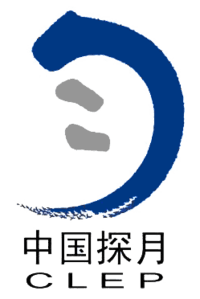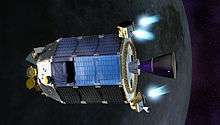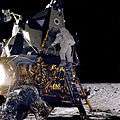Chinese Lunar Exploration Program

The Chinese Lunar Exploration Program (CLEP) (simplified Chinese: 中国探月; traditional Chinese: 中國探月; pinyin: Zhōngguó Tànyuè), also known as the Chang'e program after the Chinese moon goddess Chang'e, is an ongoing series of robotic Moon missions by the China National Space Administration (CNSA). The program incorporates lunar orbiters, landers, rovers and sample return spacecraft, launched using Long March rockets. Launches and flights are monitored by a Telemetry, Tracking and Command (TT&C) system, which uses 50-metre (160-foot) radio antennas in Beijing and 40-metre (130-foot) antennas in Kunming, Shanghai and Ürümqi to form a 3,000-kilometre (1,900-mile) VLBI antenna.[1][2] A proprietary ground application system is responsible for downlink data reception.
Ouyang Ziyuan, a geologist and chemical cosmologist, was among the first to advocate the exploitation not only of known lunar reserves of metals such as titanium, but also of helium-3, an ideal fuel for future nuclear fusion power plants. He currently serves as the chief scientist of the Chinese Lunar Exploration Program. Another scientist, Sun Jiadong, was assigned as the general designer, while scientist Sun Zezhou was assigned as the deputy general designer. The leading program manager is Luan Enjie.
The first spacecraft of the program, the Chang'e 1 lunar orbiter, was launched from Xichang Satellite Launch Center on 24 October 2007,[3] having been delayed from the initial planned date of 17–19 April 2007.[4] A second orbiter, Chang'e 2, was launched on 1 October 2010.[5][6] Chang'e 3, which includes a lander and rover, was launched on 1 December 2013 and successfully soft-landed on the Moon on 14 December 2013. It will be followed by a sample return mission, Chang'e 5 scheduled for 2017.[7]
As indicated by the official insignia, in the shape of a calligraphic nascent lunar crescent with two human footprints at its center reminiscent of the Chinese character 月 for ″moon″, the ultimate objective of the program is to pave the way for a manned mission to the Moon. Such a mission may occur in 2025–2030.[8]
Program structure
The Chinese Lunar Exploration Program is divided into three main operational phases, with each mission serving as a technology demonstrator in preparation for future missions.
Phase I: Orbital missions
The first phase entailed the launch of two lunar orbiters, and is now effectively complete.
- Chang'e 1, launched on 24 October 2007 aboard a Long March 3A rocket, scanned the entire Moon in unprecedented detail, generating a high definition 3D map that would provide a reference for future soft landings. The probe also mapped the abundance and distribution of various chemical elements on the lunar surface as part of an evaluation of potentially useful resources.
- Chang'e 2, launched on 1 October 2010 aboard a Long March 3C rocket, reached the Moon in under 5 days, compared to 12 days for Chang'e 1, and mapped the Moon in even greater detail. It then left lunar orbit and headed for the Earth–Sun L2 Lagrangian point in order to test the TT&C network. Having done that it completed a flyby of asteroid 4179 Toutatis on 13 December 2012, before heading into deep space to further test the TT&C network.
Phase II: Soft landers/rovers
The second phase is ongoing, and incorporates spacecraft capable of soft-landing on the Moon and deploying lunar rovers.
- Chang'e 3, launched on 2 December 2013 aboard a Long March 3B rocket, landed on the Moon on 14 December 2013. It carried with it a 140 kg (310 lb) lunar rover named Yutu, which was designed to explore an area of 3 square kilometres (1.2 sq mi) during a 3-month mission. It was also supposed to conduct ultra-violet observations of galaxies, active galactic nuclei, variable stars, binaries, novae, quasars and blazars, as well as the structure and dynamics of the Earth's plasmasphere.
- Chang'e 4, originally scheduled for 2015, was a back-up for Chang'e 3. However, since the success of that mission the configuration of Chang'e 4 was adjusted to test equipment in advance of the next mission.[9]
Phase III: Sample return
The final phase will entail a lunar sample return mission.
- Chang'e 5-T1 was launched on 23 October 2014. It was designed to test the lunar return spacecraft.
- Chang'e 5, expected to launch in 2017 aboard a Long March 5 rocket,[10] will build on the success of the previous missions, with a lander capable of collecting up to 2 kilograms (4.4 lb) of lunar samples and returning them to the Earth.[7]
- Chang'e 6, expected to launch in 2020 aboard a Long March 5 rocket, will build on the success of the Chang'e 5 mission.
Key technologies
Long-range TT&C
The biggest challenge in Phase I of the program was the operation of the TT&C system, because its transmission capability needed sufficient range to communicate with the probes in lunar orbit. China's standard satellite telemetry had a range of 80,000 km (50,000 mi), but the distance between the Moon and the Earth can exceed 400,000 km (250,000 mi) when the Moon is at apogee. In addition, the Chang'e probes had to carry out many attitude maneuvers during their flights to the Moon and during operations in lunar orbit. The distance across China from east to west is 5,000 km (3,100 mi), forming another challenge to TT&C continuity. At present, the combination of the TT&C system and the Chinese astronomical observation network has met the needs of the Chang'e program, but only by a small margin.
Environmental adaptability
The complexity of the space environment encountered during the Chang'e missions imposed strict requirements for environmental adaptability and reliability of the probes and their instruments. The high-radiation environment in Earth-Moon space required hardened electronics to prevent electromagnetic damage to spacecraft instruments. The extreme temperature range, from 130 °C on the side of the spacecraft facing the Sun to -170 °C on the side facing away from the Sun, imposed strict requirements for temperature control in the design of the detectors.
Orbit design and flight sequence control
Given the conditions of the three-body system of the Earth, Moon and a space probe, the orbit design of lunar orbiters is more complicated than that of Earth-orbiting satellites, which only deal with a two-body system. The Chang'e 1 and Chang'e 2 probes were first sent into highly elliptical Earth orbits. After separating from their launch vehicles, they entered an Earth-Moon transfer orbit through three accelerations in the phase-modulated orbit. These accelerations were conducted 16, 24, and 48 hours into the missions, during which several orbit adjustments and attitude maneuvers were carried out so as to ensure the probes' capture by lunar gravity. After operating in the Earth-Moon orbit for 4–5 days, each probe entered a lunar acquisition orbit. After entering their target orbits, conducting three braking maneuvers and experiencing three different orbit phases, Chang'e 1 and Chang'e 2 carried out their missions.
Attitude control
Lunar orbiters have to remain properly oriented with respect to the Earth, Moon and Sun. All onboard detectors must be kept facing the lunar surface in order to complete their scientific missions, communication antennas have to face the Earth in order to receive commands and transfer scientific data, and solar panels must be oriented toward the Sun in order to acquire power. During lunar orbit, the Earth, the Moon and the Sun also move, so attitude control is a complex three-vector control process. The Chang'e satellites need to adjust their attitude very carefully to maintain an optimal angle towards all three bodies.
Hazard avoidance
During the second phase of the program, in which the spacecraft were required to soft-land on the lunar surface, it was necessary to devise a system of automatic hazard avoidance in order that the landers would not attempt to touch down on unsuitable terrain. Chang'e 3 utilized a computer vision system in which the data from a down-facing camera, as well as 2 ranging devices, were processed using specialized software. The software controlled the final stages of descent, adjusting the attitude of the spacecraft and the throttle of its main engine. The spacecraft hovered first at 100m, then at 30m, as it searched for a suitable spot to set down. The Yutu rover is also equipped with front-facing stereo cameras and hazard avoidance technology.
Potential cooperation with Russia
Anatoly Perminov, head of the Russian Federal Space Agency, revealed in September 2006 in RIA Novosti that Russia and China were working on lunar exploration as partners, and that the Russian-Chinese Space Sub-Commission's priority was to conclude a joint lunar exploration agreement by the end of that year.[11]
See also
- Chinese space program
- List of current and future lunar missions
- List of proposed missions to the Moon
- List of missions to the Moon
- Robotic exploration of the Moon
References
- ↑ (Chinese) “嫦娥奔月”地面主干工程基本完成 云南天文台巨型射电追踪望远镜年底投入使用
- ↑ 巨型望远镜送“嫦娥”飞月-望远镜,嫦娥-北方网-科技无限
- ↑ ""嫦娥一号"发射时间确定 但未到公布时机". Xinhua News Agency. 2007-07-07. Retrieved July 12, 2007.
- ↑ (Chinese) 阅读文章
- ↑ Stephen Clark (1 October 2010). "China's second moon probe dispatched from Earth". Spaceflight Now. Retrieved 1 October 2010.
- ↑ "China's 2nd lunar probe Chang'e-2 blasts off". Xinhua. 1 October 2010. Retrieved 1 October 2010.
- 1 2 "China's Unmanned Moon Mission To Bring Back Lunar Soil To Earth". AsianScientist. March 21, 2012.
- ↑ "China considering manned lunar landing in 2025–2030".
- ↑ "China Celebrates Lunar Probe and Announces Return Plans". New York Times. 2013-12-16. Retrieved 16 December 2013.
- ↑ "China plans to launch Chang'e 5 in 2017".
- ↑ "Russia, China could sign Moon exploration pact in 2006". RIA Novosti. 2006-09-11. Retrieved September 14, 2006.
- Sūn Huīxiān (孙辉先), Dài Shùwǔ (代树武), Yáng Jiànfēng (杨建峰), Wú Jì (吴季) and Jiāng Jǐngshān (姜景山) (2005). "Scientific objectives and payloads of Chang'E-1 lunar satellite" (PDF). Journal of Earth System Science. 114 (6): 789–794. Bibcode:2005JESS..114..789H. doi:10.1007/BF02715964.
External links
| Wikimedia Commons has media related to Chinese Lunar Exploration Program. |
- CLEP official website
- Encyclopedia Astronautica
- The Scientific Objectives of Chinese Lunar Exploration Project by Ouyang Ziyuan
- 我国发射首颗探月卫星专题
- 嫦娥探月专题


